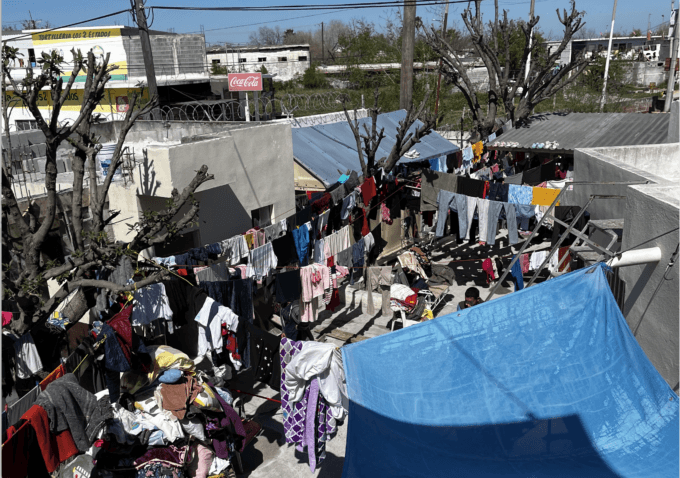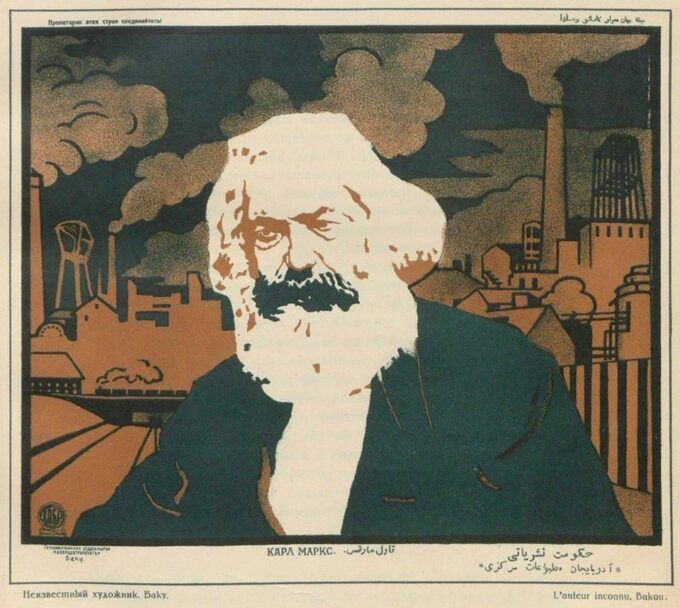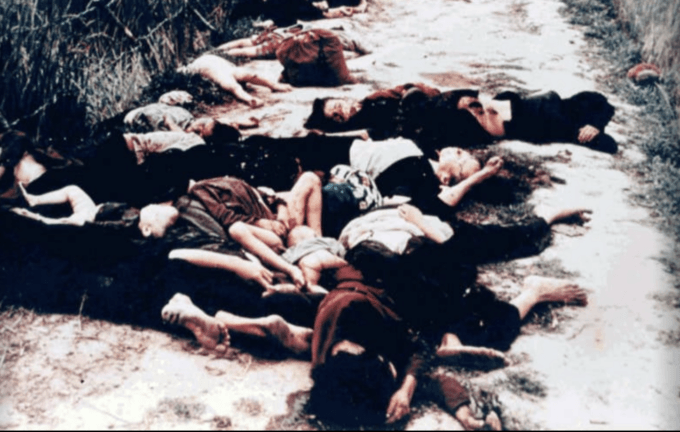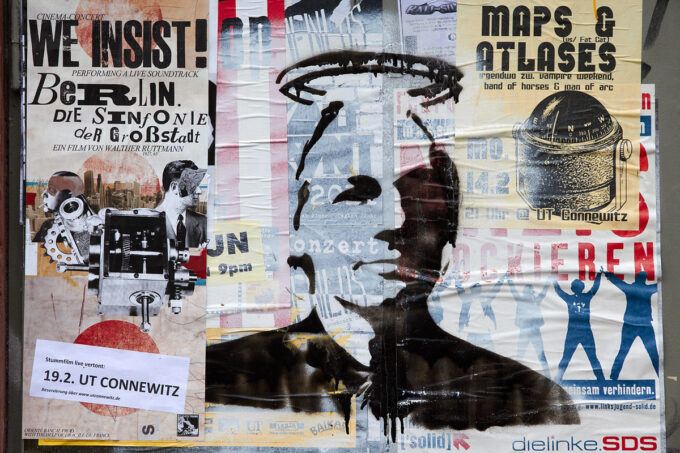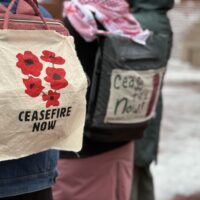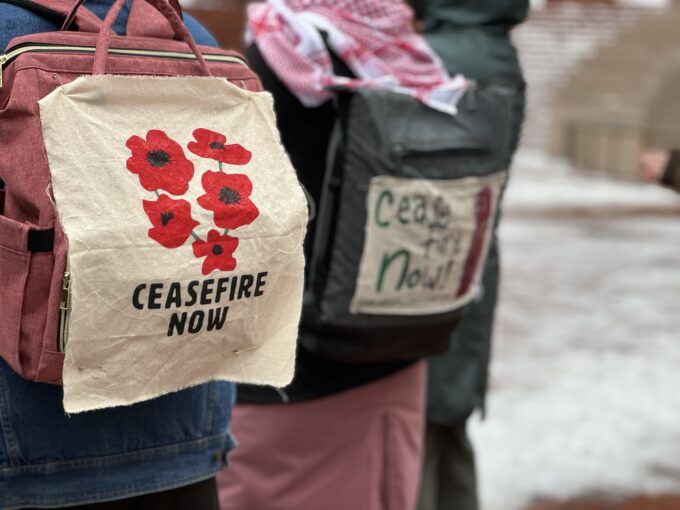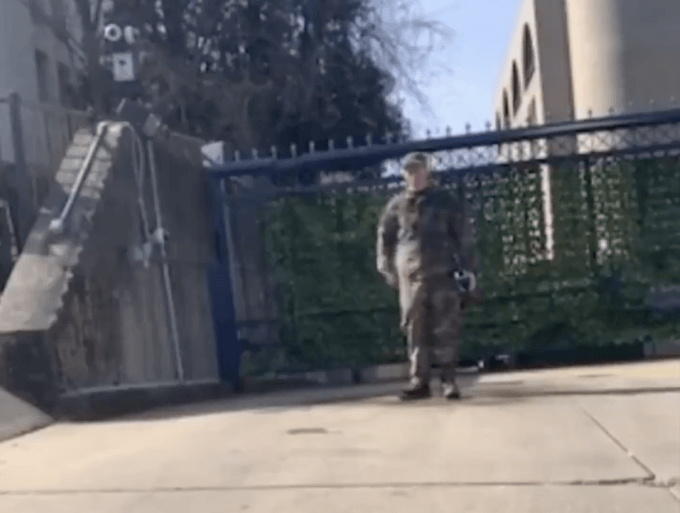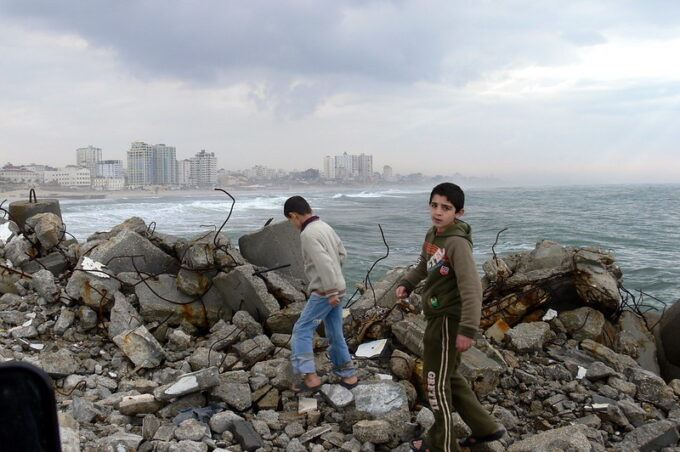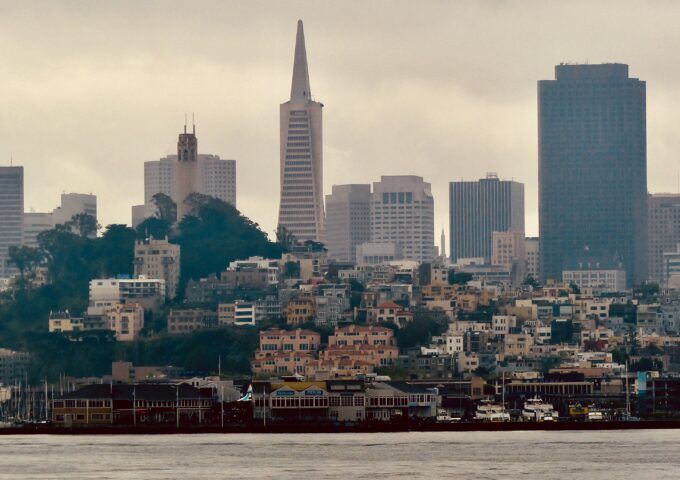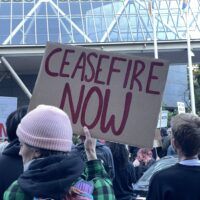
In 1958 the assistant headmaster did the Bible reading at the morning assembly of the Karachi Grammar School (Pakistan), founded in 1848 by the Church of England.[1] The reading from Acts 17:23 concerned St. Paul’s declaration upon seeing the Athenian monument to an unknown God. “What you worship but do not know—this is what I now proclaim,” at which point I, seventeen years old at the time, shouted the answer for all to hear: “Communism.”
As a child of both British and American empires I had come to this rebellious conclusion two years earlier at the Frankfurt Army High School. Based on study of The Communist Manifesto which I conducted in the library of the Officers Club at the I.G. Farben building, I was able to answer this ancient question posed in the Athenian agora by a man from Palestine.
I approach the wars in Palestine neither as an Arabic nor a Hebrew scholar or even as one knowledgeable to other forms of life in the region—olive, almond, fig, citrus fruits, sheep, cotton, or grains like wheat. I come as a student, with a life-long admiration for the radical, abolitionist, and antinomian traditions: Jesus and the prophets, Karl Marx, Gerard Winstanley, Thomas Spence, Olaudah Equiano, the IWW, Frederick Douglass, Shunryu Suzuki, Elizabeth Poole, Ann Setter, Ivan Illich, Malcolm X, William Blake, Silvia Federici, E.P. Thompson, Robin Kelley, Manuel Yang, Michaela Brennan, Midnight Notes, CounterPunch, and Retort; and then I became an historian of all the above with particular interest in the commons. As Marcus Rediker and I said in the introduction to the Arabic translation of our Many-Headed Hydra, Herodotus, “the grandfather of history,” explained that Palestine lay between Phoenicia and Egypt.
Besides going to Athens, a home of philosophy (philia = love, Sophia = goddess of wisdom), Paul went to gatherings where they had “everything in common” (Acts 4:32). Jubilee was another Biblical thing I could cotton on to because I love its principles of land back, freedom now, no work, debt forgiveness, and rest for revered mother Earth. It all seems to me a beautiful combination of revolution and relaxation. Paul became a follower of Jesus who was thrown out of his hometown and almost killed for proclaiming jubilee right now. He called for rest and forgiveness. The only economic basis of such a thing is the commons. The struggle in Palestine helps us see this.
I believe that the musha’a (community-owned agricultural lands), like similar practices anywhere else in the world, can help us realize a world based on just conditions of mutuality, name it as is your wont: true communism, the cooperative commonwealth, the commons. The renewed thinking of the commons was born of struggles against the new enclosures of the neoliberal era and inspired by the commoning practices of autonomist Zapatista communes in Chiapas and its defense of the ejido. The commons is now understood as a key conceptual breakthrough in orienting visions and pathways to postcapitalist futures. The commons also marks the radical escape from the paralyzing misfires and legacies of modernist state socialisms.[2]
I must write about the musha’a, a Palestinian form of land tenure, or the commons, which the Ottomans, the Brits, and the Israelis attempted to destroy. It includes collective ownership, cooperative labor, and periodic redistribution. These are principles also found in the earliest promulgation of debt cancellation, freedom from servitude, and restoration of land tenures. In addition to jubilee, it was espoused by Enmetena, a ruler of Lagash, around 2400 BC and evolved into general proclamations of amnesty.[3] The musha’a was a defensive institution against the fear of taxation and military recruitment by the Ottoman authorities.
Palestine’s planetary significance is threefold: first, there is its geography at the conjunction of three continents, Asia, Africa, and Europe, and the waters among them. Second, there are the extractions from the soil of Palestine, as well as from under it (grains, minerals, oil and gas). And third, there is Palestine’s significance concerning Christianity, Islam, and Judaism. Three big religions, three big continents, and original economies of cultivating the earth, mining the earth, and drilling the earth, making modes of production from the “fertile crescent” to the petroleum present with its terrible planetary perturbations. The struggle for the liberation of Palestine has geographic breadth and historical depth, which explains why it is considered the “soul of the souls of all our struggles.” The whole world has awakened to it.
To introduce the subject further, though at the risk of passing from the contemporary sublime to the ridiculous antique, let us attend to a paper delivered on 20 January 1890, at the Victorian Institute in London by James Neil, M.A. He explains how in southern Palestine the arable soil was apportioned by lot.[4] He said, “the persons proposing to work the ground divide into groups, and the chief of each group draws a section of the land proportioned to the number of persons in his group. Each section is composed of lands of various fertility and qualities. These sections are again subdivided by measurement with an ox-goad, or a line called habaleh, the counterpart of the measuring line [as noted in Biblical] Scripture. The farmers, in such regions as possess this custom, prefer this method of communistic division to holding in fee simple.”
“Fee simple” is feudal locution, an English legal term for private property: you can use or abuse it, you can bequeath it, you can alienate it, you can sell it, and above all you can exclude others.[5]Roman law refers to fructus, abusus, and usus, or fruits, abuses, and uses. The idea of individual, exclusive land ownership is, according to its historian, Andro Linklater in his book Owning the Earth, “the most destructive and creative force in written history.”[6]
The Palestine Exploration Fund was founded in 1865 and carried out surveys and ethnographies of Ottoman Palestine. It was an Anglican operation financing archeologists and clergymen. “We are about to apply the rules of science,” said the Archbishop of York in Westminster Abbey at its founding, “to an investigation into the facts concerning the Holy Land.” The Quarterly Statement of the Palestine Exploration Fund for April 1891 includes this in its survey of land tenure and agriculture in Palestine: “… in Southern Palestine, and in a few other districts, the land is held in common by all the inhabitants of a village, and apportioned at stated times to the individual cultivators according to their ability to cultivate, their standard being the number and power of the cattle used for ploughing. Such lands are known as, musha’a.”
In 1865 in addition to the founding the Palestine Exploration Fund evangelical Christians in England formed the Victoria Institute to defend “the great Truths revealed in Holy Scripture … against the opposition of science so called.” Its leaders were Christian Zionists. The commons and communism were easily linked in the mind of the Church of England. In contrast to jubilee and other sacred Bible texts the 38th of its 39 articles of religion simply states, “the riches and goods of Christians are not common as touching the right, title, and possession of the same….” Let us look at this more closely considering the musha’a and communism.
In addition to Bedouin practices of common pasturage, the musha’a as a village-based agriculture was another version of commons in land, and was collectively owned by the village, whose individual members owned shares (ahsahm) in its use rights. These included the right to sow, to plough, to cultivate, to harvest. The threshing barn, like the land, was held in common. Secondly, the musha’a allowed the redistribution and equalization of ahsahm to different family groups at one- to five-year intervals. These rights were heritable and were determined by the wants and needs of the cultivator.
When James Reid spoke of “communistic division” in contrast to fee simple what did he mean? The specter of communism haunts not only Europe as Karl Marx and Frederick Engels wrote in The Communist Manifesto (1848) but Palestine too says James Reid, M.A., to the Victorian Institute. “In this sense, the theory of the Communists may be summed up in the single sentence: Abolition of private property.” To what sense were Marx and Engels referring? They mean the employment of property as the means of exploiting others, capital in other words. Marx elaborated on his understanding of communism years later when his Critique of the Gotha Program was published the very same year, 1891, that James Reid read his paper to the Victorian scholars of empire. Here he repeated the common definition among revolutionaries of 1848 and whose sense originated earlier with Gracchus Babeuf during the French Revolution.[7] “From each according to their abilities, to each according to their needs.” The principle applies to the musha’a in which capabilities and wants are collectively decided. Communism and commons begin to overlap.
The musha’a evolved over four hundred years under the Ottoman Empire, which claimed to own the land as a rule for tax purposes on miri land. It arose in the village, not the state, as a system of collective land tenure for cultivators who comprised the vast majority of the population. Efforts to install private property by Ottoman reform, or British mandate, or Zionist occupation met with determined, persistent resistance in “the land-equalizing musha’a village throughout Palestine.” “There was no need for land reform, which only proved destructive to the economy of the fellaheen. It nullified the advantages inherent in the system and, unexpectedly, facilitated the transfer of lands from Arabs to Jews.”[8]
Samuel Bergheim wrote an early description of musha’a for the Palestinian Exploration Fund. From a European banking family, Bergheim bought property in Palestine with title deeds accepted by the Ottomans.[9] “When my brother and I bought the lands of a village some years since from its inhabitants, the Turkish authorities recognized us as the freeholders, and gave us title deeds, in accordance with a law on freehold passed by the late Sultan about twenty years ago. Not so, however, [for] the inhabitants of the village, for when we came to portion out the land in plots for cultivation, the villagers protested and refused to accept the new arrangement. They would only have the land in musha’a.”
The Bergheim family bought land in 1872; in 1885 Peter Bergheim was murdered. Gezer was also the site of one of the earliest encounters between settler colonialism (the Bergheim estate) and peasant resistance to the imposition of the land privatization code of 1858, in which the communal (musha’a) system was undermined. The murder of Peter Bergheim—banker, settler, and amateur archaeologist—by Abu Shusha peasants highlighted the dynamic relationship between archaeology, early European agricultural settlement, and peasant dispossession of land.
Noura Alkhalili explains that the musha’a was “a once-prominent Levantine culture of common land.”[10] She describes a major way that the village musha’a, a largely agrarian commons, was transformed in an urban environment following the violence of mapping, titling, buying, and selling which cast people into cities and camps following their expropriation from the land. The transition was catastrophic: the fellaheen became refugees and the refugees became proletarians. The process was aided by the Oslo accords of 1993 and 1995, which banked on neoliberalism’s private property and market relations, and on the neoliberal theory of “economic development.” In Palestine, unlike England, it was more than fences and hedges—it included the thirty-foot separation wall on the West Bank built between 2005 and 2008 after the Second Intifada.
How has the diaspora of the fellaheen carried on these notions of reciprocity, obligation, and mutual aid, whose origins are found in the musha’a, and whose values lie with the family, within the heart of the community, and the breast of every person? How are such principles transferred from the country to the city? What do refugees carry in their heart besides the paltry few belongings in their cart or car? What practices nourish and carry the collective wisdom of survival and resistance? Food, dwelling, security, health care, and water are immediate needs.
Noura Alkhalili who did her field work in 2013 writes “The fellaheen in Palestine did not need any borders to identity their plots; fig and olive trees were convenient landmarks for everyone in the community.” She also explains how both houses and trees could become private property. Trees were mnemonic too as reminders, survivors. About John Berger, the art critic with a Tolstoy-like love of peasants, it is said that “the medlars and mulberry trees of Ramallah reminded him of the time before the Nakbah when it was a town of leisure and ease.” “As long as grass grows,” is the indigenous saying from Turtle Island. Les Levidow explains that one Palestinian response to the systematic re-engineering of land and the expropriation of Arabs from it, has been the “unauthorized” planting of olive trees. The olive has been a primary cultigen of Palestine for at least eight thousand years.
For Alkhalili, “The fellaheen resistance from below, against the British project of enclosure and commodification of land, was ultimately about the protection of the commons.” She reports from the Shu’faat refugee camp of East Jerusalem and how Palestinian contractors built high rises on musha’a land preventing Israeli’s from using it to build the separation wall. She refers to “the quiet encroachment of the ordinary,” that is, the coming of street vendors and houseless folks. “Enclosures from below are what happens when propertyless subalterns encroach on commons.” They too take steps to privatize property: “a process of class formation has occurred, tied to the individual appropriation of musha’a land,” which raises the question, “Is this rather a form of submission to both prevailing capitalist and colonial systems?” She continues, “While in parts of the world, we can witness indigenous and activist movements seeking to reclaim the commons from private ownership, the opposite is happening in Palestine.”
In 1895 Theodore Herzl, author of The Jewish State and founding father of Zionism, confided in his diary, “We must expropriate gently the private property assigned to us….” Jabotinsky’s 1923 essay “The Iron Wall,” as well as Herzl himself, compared the Zionist project to the expropriations of the English and American colonists. Eighty percent of Arab land has been taken since 1948. Among the methods used in this expropriation is digging deeper artesian wells for water. A third of the Israeli water supply is pumped from the West Bank. The domestic, municipal, agricultural, and industrial hydrological system is controlled by an Israeli water company.[11]
Noura Alkahalili bears close and scrupulous witness to the urban transformation of musha’a under conditions of hostile occupation. Gary Fields, for his part, provides a historical mirror for our reflections.[12] His study is in three parts: English enclosures, Indigenous American conquest, and Palestinian colonization. These are three “cases” of enclosure. English ideas and practices “migrate” to America; English enclosures are in the same “lineage” as Palestine’s. The re-mapping and boundary-making conform to the modernization and territorial ambitions of estate owners. “In each case, systems of landholding deriving from custom and imbued with collective rights of use and cooperative forms of management came under attack by modernizers.” In three parts Gary Fields analyzes enclosure in England from the 14th to the 18th century. He describes the conquest and reservations of indigenous people in North America, and finally he describes the Palestinian case or the settler colonialism of the Zionists. Capitalism, colonialism, and nationalism are the terms that are offered in an attempt to generalize from the “cases.” Maps, laws, and fences are the techniques of acquisition and possession. For England it was profit, for America it became race, and for Palestine it was religion. “These three case studies of dispossession offer distinct pathways to modernity,” he writes, and we might just as well say the three cases are three lanes on the same super highway going in the same direction, namely “modernity,” or perdition.
Fields employs Edward Said’s term “imaginative geography” as a first step in colonization, from which maps and a landscape will be realized. Land rights are rights of exclusion, delimiting mine from thine, to use an old phrase. Under the Ottomans, cultivators of Palestine created “a unique system of communal tenure known as musha’a—gave villagers control over cropping practices and spread the risks of subsistence agriculture.”
+++
With the collapse of the Ottoman empire at the end of World War One, the British were mandated to govern Palestine. The infamous Balfour declaration promised the banker Rothschild “a national home for the Jewish people.” Under the British mandate 70% of village lands were still held in musha’a tenure. English land policy was hostile to musha’a. Sir Ernest Dowson, engineer and surveyor, advocated enclosure and partition of common land. He completed the first cadastral survey of Palestine. In 1925 his “Preliminary Study of Land Tenure in Palestine” was in full continuity with the classic advocates of the destruction of the English commons, namely, Arthur Young, John Sinclair, and William Blith.[13] The British succeeded in surveying and entitling 25% of Palestine. This weakening of musha’a was a victory for the Zionist movement, as land could now be bought and sold. Even still, by 1947 Zionists had obtained by purchase less than 10% of arable Palestinian land—the village and aspects of musha’a still dominated. Ernest Dowson led the work of land registration. He led the cadasters, surveyors who made cadastres, or registers of extent, value, and ownership of property. Their work paved the way for Zionist colonization.
Then again, in the Peel Commission of 1937, the musha’a was identified as a disincentive in face of stubborn resistance. The Arabs regarded the musha’a “as a safeguard against alienation,” to quote the Commission. Perhaps it is this relation to the land in the face of the British Empire that gave to the fellaheen its world-famous character, expressed in the Arabic word sumud, or steadfast.
The struggle is for liberation not for a new state. “The British Mandate’s survey and cadastral and mapping project … sought to centralize power and decision-making away from the indigenous population… [The] project’s largest obstacle: the musha’, a land-equalizing system managed directly by the peasants themselves.”[14] “The musha’a was characterized by the periodic redistribution of agricultural plots among peasant cultivators who held claims to parts of the land in the form of shares.” “The continual practice of negotiating land redistribution placed emphasis on relationships, accountability, and affective ties among villagers.”
The fence, the hedge, the wall, the haw-haw, razor wire, barbed wire, brick and cinder block became the means and symbols of this vast enclosing. Such architecture joined law (criminalization of custom) and cartography (theodolite, chains) to destroy communities based on common lands. In England they called such lands “waste.” In America it was called “wilderness.” Or in the language of the Roman empire, Latin, which instead referred to terra nullius or vacuum domicilium. Children sought “vacant lots” for their play, sports, and games. In contrast to the vernacular whose outstanding genius was the poor poet and deep commoner, John Clare, beloved two centuries later in Palestine which is neither a ‘nothing land’ or a ‘vacant domicile.’ The olive, the fig, the apricot, the vine, the pomegranate, the walnut, almonds, oranges, and lemons were Palestine’s fruits. 70% of arable land at the time of the nakbah still was held as musha’a.
The musha’a village resembled the English village with its collective decision-making, resource allocation, fruits of open field agriculture, and basket of common rights. Land in England assumed many forms: meadow, woods, fens, heaths, fells, moors, marsh, uplands as well as arable lands. Each had ecological features particular to it and therefore modes of customary appropriation that also were distinct. The world knows the process thanks to English literature. Robinson Crusoe (1719) is the classic text of individualism, enclosure, possession, and conquest. The radical English poet, William Blake, at the peak of revolutionary movement against oppressors and enclosers, those who sought in the name of profit and commerce (“improvement” they called it) to close the open fields, wrote that “to create a little flower is the labor of ages,” and then again that “improvement makes straight roads but the crooked roads without improvement are roads of Genius.” The English “right to roam” is related to the Palestinian “right to return.” Enclosure brings about odium because it amounts to dispossession, impoverishment, depopulation, forced migration, dearth, nostalgia, sadness and trauma. The hedgerow materialized enclosure, so did the straight road.
Through struggle, the musha’a will be transformed. Vestiges of mutuality remain today, even in the city and its refugee camps following the violence of war, dispossession, and privatization of land. Violence always accompanies expropriation. Ernest Dowson himself compared it to the Parliamentary enclosures of the 18th century. Lord Balfour in his diary compared the colonization of Palestine to the dispossession of the Sioux, or Lakota people, about which we may learn from Nick Estes and the Red Nation who have raised the world cry, “Land Back!”
Indigenous people of North America cultivated plants with three outcomes: 1) corn became the mainstay among “the three sisters” (corn, beans, squash), 2) women tended these crops, and 3) the village became the basic unit of society. These were undermined by “A discourse of land improvement and property rights—supplemented with notions of savagery and racism – [which] settled upon the landscape …. Checkerboard grid of municipal, county boundaries within which indigenous people were enclosed in reservations. “The most striking … finding in Enclosure, is the enduring influence of ‘land improvement’ as the ideological inspiration for the reimagination of landscape and a driver of the process to enclose and take possession of land.” Maps, laws, and fences are the techniques of acquisition and possession. For England, land improvement meant profit. What did “improvement” mean?
+++
Commoners in England, as with native Americans, were cast as “savages.” As such they belonged to far-away places (India, America, Africa) in far-away times (B.C., neolithic, feudal). To Arthur Young, the theorist and first comprehensive chronicler of enclosure, commoners were “the Goths and Vandals of the open fields.” Linking commoners of the metropole with indigenous people of the world in the stadial interpretation of human history and its four stages leading to “civilization” or “modernization.” and likewise linking commoners and indigenous people against economic “progress,” “improvement,” or “development,” the buzz words of planners, politicians, and policymakers everywhere.
An older study spoke of “stages,” not “cases.” What is the difference? Fields does not write of work and the continental re-organization of labor nor of money and the global investment to maximize surplus value. The bourgeoisie produced theories of historical change with economic determinism by describing human history in four or five “stages” of economic growth. William Roberton’s History of America published in 1777 in the midst of the American War of Independence developed the “stages” theory of the progress of “mankind” from savagery to civilization. Scotsmen such as Adam Ferguson and Adam Smith produced the sociological and economic theories for the stages – primitive communism, pastoralism, agriculture, and commerce, or in other words – savagery, barbarism, feudalism, and capitalism. Fundamental in each was the technological relationship to the earth as well as class differentiation and patriarchy. Gathering herbs, hunting in the forest, cultivating the soil, subterranean mining, until quantity overcame quality in incessant demonic accumulation. It was a powerful but illusory theory propounding both determinism and inevitability. The dynamic of change from one stage or mode of production to another occurred as revolution.
In 1878 Vera Zasulich attempted to assassinate the mayor of St. Petersburg and served time in prison for it. Three years later in March 1881 Czar Alexander II was assassinated in St. Petersburg. A month earlier Vera Zasulich found herself with a “life and death question” to put to Karl Marx. Can the rural commune (the obshchina) develop in a collectivist and socialist direction, or is it destined by the laws of history to perish as an archaic form? Is it just a phase from the past or is it a seed of the future? Marx’s response was interesting. He wrote four drafts of a letter to her. In the end he sent her a relatively brief reply and no uncertainty in his conclusion: “The special study I have made of it, including a search for original source material, has convinced me that the commune is the fulcrum for social regeneration in Russia.” The previous four drafts provide us with an idea of his “special study.”
In his letter to Zasulich, Marx quoted from Capital, whose first volume she would go on to translate into Russian. He stated that “the expropriation of the agricultural producer, of the peasant, from the soil is the basis of the whole process.” Marx writes her about “all the historical twists and turns” or the “frightful vicissitudes” which characterize such transitions. To her he makes a powerful distinction between the “archaic commune” when communal residence was in a single house, as with the Haudenosaunee or “people of the long house,” when kinship and communal membership considerably overlapped, and production was collective unlike the agrarian commune where the open field was divided into individual strips. Labor and land were collective in the archaic commune, while a dualism prevailed in the agrarian commune, with some collective elements and some individualist elements. Marx warned Zasulich that “to save the Russian commune, there must be a Russian Revolution.”[15] Marx’s view of history is not linear but rather spiral: the past is not dead, and in fact it is not even past. Hence, “the return of modern societies to a higher form of an ‘archaic’ type of collective ownership and production.” He thus links the commons to the commune.
For us too this is the quandry faced in Palestine. Again events compel us to think of alternatives to privatization. Again we ask what is communism? For a definition we go again to Karl Marx who wrote a few years earlier in The German Ideology (1845), “We call communism the real movement which abolishes the present state of things.” He puts practice ahead of theory. He says this in a context which rendered the great mass of humanity propertyless, destitute, and wanting. And yet it existed “world-historically.” Years later, in The Critique of the Gotha Program, composed in 1875 and published in 1891, he insisted that “every step of real movement is more important and a dozen programs.”
+++
Protestations against private property did not originate with Karl Marx. They are worldwide, and history is full of them. Here are three examples. In 1794, from England’s oldest settler colony, Ireland, William Drennan (1754–1820), founder of the United Irishmen, coiner of the jewel “the emerald isle,” wrote as part of his defense against sedition, “By attaching the oldest inheritance of the whole people to certain round spots of earth, gives a locality to liberty, inconsistent with its nature: turns legislators into land-measurers and land-measurers into legislators; extending lines of demarcation, on the one side of which privilege is heaped up, and on the other common right trodden down.”[16]
Or, at the time of colonization of Massachusetts the indigenous sachem Massasoit of the Wampanoag, asked, “What is this you call property? It cannot be the Earth for the land is our Mother nourishing all her children, beasts, birds, fish, and all men. The woods, the streams, everything on it belongs to everybody and is for the use of all. How can one man say it belongs only to him?”
And we have George Jackson’s questions from inside the Amerikkkan system of mass incarceration: “Who has done the most dying? Most of the work? Most of the time in prison (on Max Row)? Who is the hindmost in every aspect of the social, political, and economic life?”
Idealists seeking reform often return to study life on the planet prior to the privatization of property or the dominion of money and market. Land is the ancient foundation of human society and the grounding of the entire biome.[17] Neither state nor nation, neither imperium (sovereignty, war) nor dominium (borders, property). Instead, omnia sunt communia.
The musha’a evolved with the miri agrarian policy of the Ottomans, which comprised 87–90% of agricultural land of the empire. By 1914, the end of the Ottoman empire, the musha’a amounted to 70% of total land. It constituted 55% of the cultivated land in 1922; 46% in 1930; 25% at end of Mandate. However, only a fifth of the total land of Palestine had been divided into demarcated units. In 1947 Jewish settlement amounted to 8% of land surface in Palestine. By 1947 only 20% of land was settled with title. By 2017, Zionist settlement and infrastructure covered 85% of the territory.
It was not just law that modern colonists took from the Roman empire of old. Soldierly virtues, honor, fortitude, suffering, wounds, loss of limbs, blindness—were extolled. A huge array of cunning military punishments were passed down. It was a patriarchal affair, teaching the young men and boys how to die, obedience to the state, rape upon Mother earth, and white supremacy with its albifying powers to effect discourse, iconography, and structures of knowledge. “Whiteness” was born in the chromatics of alchemy as albification. This is what the young Marx meant when he wrote, “To have its sins forgiven mankind has only to declare them to be what they really are.” (1843). The sin here is theft of land. To forgive this sin is to give it back. But as Caliban said,
This island’s mine by Sycorax my mother,
Which thou tak’st from me.
Was not Sycorax from the Levant? These are remnants of one European empire to another. Yes, true, but just as foundational are the women, whose labor gives life, the preserver of community, the keeper of the hearth, responsible for the reproduction of human.
When it was said by the Romans of the quasi-independent plebeians that the proletarians were good for nothing except having babies, they gave us the word ‘proletarian’ understood around the world. It refers to women especially, to aunts and “aunties,” to nannas and grannies, to sisters, and to sisterhood. This is why in South African it is said “touch the woman, touch the rock.” Women make the human community—cooking, safety, care, and memory. In any world-system, whether it is called savagery, barbarism, feudalism, capitalism – whatever – you will find women responsible for its reproduction. This is now truer than ever. The extended family, or hamula, was the basis of the village community and the musha’a.
Gary Fields distinguishes imperium from dominium following a distinction made under Roman law, where imperium refers to the territorial extent of royal sovereignty and dominium refers to the right to possess land within the imperial boundaries. One sticks a flag into the ground, the other erects a fence. Both bring the fort, the border, and violence. Imperium and dominium may parallel the difference between discovery and settlement. What is omitted is the transition from one to the other and the means of making that transition: war, disease, rape, and rapine! Rule by the stick – husbands beating wives, parents beating children, masters beating journeymen, masters whipping slaves, officers flogging sailors, &c. The former inhabitants whose “discovery” was so heralded by Christian missionaries are “absent,” killed, or if they survive they become self-alienated and shadows of their former selves poisoned by alcohol, shamed, dishonored, raped, destined to die young.
+++
Christian Zionism is as old as capitalism. It dates from the 16th century. In England it reached an important peak at the time of Oliver Cromwell, the great commander of the English bourgeois revolution. Cromwell’s secretary argued that the Jews should go to Palestine. At the same time, after hundreds of years exclusion, Jews were permitted to return to England under Cromwell. Kinship and commerce linked the Sephardim Jews from Amsterdam to the Mediterranean to the Atlantic. Cromwell asserted himself as an imperial sovereign ready to compete with the other imperial powers and none of these had as great a reach as the Dutch. Cromwell was a bourgeois commander who exerted his people by war. He reduced obstacles to the enclosure of land, invaded Ireland, defeated Spain, captured Jamaica. And he was a Zionist. This was Jihad, Protestant style done in the name of Jahweh.
When Oliver Cromwell chopped off the King’s head and inaugurated the capitalist state, he appointed Walter Blith as surveyor of confiscated royalist estates. Blith summed up his years of confiscation with a linguistic sleight of hand worthy of George Orwell’s double-think. In 1649 he published The English Improver, followed in 1652 by The English Improver Improved, which links confiscation, simple robbery, the privatization of the commons with human progress. Land theft becomes agricultural improvement! Therefore to howl against such robbery is to waste your breath. To resist is to oppose the future. It is to steal your land for your own good. This sleight-of-hand has proved essential to capitalist development, the creed of the World Bank and the International Monetary Fund. Gary Fields says, “Not only was the musha’a seen as an impediment to local agricultural development and Zionist acquisition but it represented a non-productive use of natural resources inconsistent with European notions of ‘improvement’ and ‘development.’”
As Marx pointed out, “Cromwell and the English people had borrowed speech, passions, and illusions from the Old Testament for their bourgeois revolution.”[18] A number of Cromwell’s close advisors came into contact with Dutch-based Jews and advocated Jewish resettlement in England (they had been banned from the country since the 13th century). Millenarian eschatology (the messiah and the Second Coming), imperialist commercial competition, the Atlantic slave trade, and the colonial settlement of Massachusetts Bay combined. Two Baptists petitioned in January 1649 for Jewish readmission: “That this Nation of England, with the inhabitants of the Netherlands, shall be the first and the readiest to transport Israel’s sons and daughters on their ships to the land promised to their forefathers, Abraham, Isaac, and Jacob for an everlasting inheritance.” Christian Zionism is inseparable from the imperial beast from the English Revolution to the present.
If, like Fields, we compare the three cases as three “acts” in a drama, the unifying plot is missing. The “cases” have an actual, historical relationship to one another: the enclosures in England led to war and the colonization of Ireland, as well as to the creation of North American colonies, each of them a plundering search for new commodities and new means of expropriation and enslavement of labor. Inasmuch as the wealth generated by the eradication of North American indigenous landscapes (the railways, the great plains) led to an insatiable demand for petroleum, the thirst for resources lurks too beneath the ravenous appetites in the Middle East (the oil, the pipelines, Zionism). This was the bourgeois revolution (1649) whose effects are on a par with the French (1789) or Russian (1917) revolutions. One would not want to substitute “stage” for “case” to resolve the problem; instead, the issue of interpretation requires an understanding of enclosure that is a necessary feature of the expansion of the system of capitalist relations.
At a theoretical level, capitalism, colonialism, and nationalism are inter-connected, even though imperialism is inherent to capitalism, which obeys the fundamental law, the impulse of the whole system: “Accumulate, accumulate! That is Moses and the prophets!” writes Marx. National liberation is inherent to the resistance of colonialism, though it may accommodate easily, as Fanon explained, with capitalism.
This is how the proletariat is created. In those parts of Palestine dominated by tenancy to landlords “the peasant cultivators are a shiftless class … and almost to a man in debt,” according to the reporter to the 1891 Palestine Exploration Fund. This debt inevitably causes him to yield his claim to the land, and in so doing he “becomes a Sherîk-el-Hawa (Partner of the Wind).” One can imagine how a poet might interpret this Arabic figure of speech. Mother Earth has expelled her ancient cultivators, who now disperse through the world, like seeds, to join the various others in the atmospheric diaspora. And there are many winds to pay attention to: the harmata, which blows from the Sahara into west Africa; the El Ñino, which builds from the Pacific Ocean into hurricanes. The power of those partners of the wind will be reflected down the ages in Anglo cultural production, from the painted murals inside restaurants that remind customers of home, to such sublime expressions of wind as Shakespeare’s Tempest or Herman Melville’s Typhoo.
Proletarians can’t rub two coins together. They have no land, no village relations, no subsistence, no wage. This is why the partners of the wind are so important: as proletarians they will carry with them the musha’a, steadfast. Sumud. The rock. To stand confidently, relaxed, firmly—a word akin to “upright,” which also combines social virtue with the physical upright posture of the body. Like righteousness, it is associated with truth, valor, probity, and principle: what do you standfor? It is nothing less than the transition from expropriation to exploitation. “The starting point,” Marx calls it, of the capitalist mode of production. This tearing apart, this separation, this wrenching asunder, the “irreparable break,” or the “metabolic rift.” In that transition from expropriation to exploitation, there’s a pause. Ed Emory, after traveling with migrant workers on the Red Sea observed: “These are the people who wait—wait their turn, wait in line, wait in huddled groups, wait looking through the gaps in the dock gates, wait for some official to deign to notice their existence. Always waiting.” They are, he says, “the people of the earth.”[19]
+++
Returning to the present moment in Palestine, we must add to the formulation “X squared” (exploitation and expropriation) a dark shadow to each of its parts: exploitation + extermination, expropriation + extraction. The genocide being perpetrated by the Zionists in Gaza is conjoined with the extraction of land and oil. X squared is brought to X cubed by adding “excuses.” The devastation, genocide, poisoning, and plunder of the ruling class is fobbed off in a series of institutionalized excuses: economic development, modernization, social improvement, personal security, and religious salvation. Each of these excuses has its discourse, its militarization, academic setups, racism, and politics. Like all excuses, on their face they seem plausible, normal even, until their shadows emerge as they have in the Gaza war for all the world to see. The global system of empire, war, and slavery has only led to an planetary system of flood, fire, poison, and disease. With these multiple catastrophes we anticipate the despoilation of the earth systems.
Although the prophet Micah promised each of us a fig tree (Micah 4:4) let us forgo archaic prophecies and conclude on a healing note of etymology. Gaza was a textile center and gave its name to a most useful weaving: gauze, the loosely woven fabric of cotton, silk, or linen used as a wound-dressing thanks to its ability to absorb blood and to act as a barrier to its further loss.
We have gone past the point of no return. Nevertheless, we are at a turning point. David Graeber and David Wengrow write, “we are living in what the Greeks called … Kairos—the right time—for a metamorphosis of the gods, i.e. of the fundamental principles and symbols.”[20] These chroniclers of the first or earliest world-wide human social formations call this “the right time,” the time of transition to another social formation. Gendered, racialized, imperialist capitalism has ruined everything, almost. Who or what among us will bring about the required metamorphosis?
To answer this question we need not return to the dawn of everything. The musha’a of Palestine may guide our transition from one disastrous world and outlook to another: to the commune and the commons. And their relationship? We recall Marx’s reply to Vera Zasulich: “It is a question no longer of a problem to be solved but simply of an enemy to be beaten.”
Notes.
[1] Thanks to Andrej Grubacic who invited me to write this for The Journal of World Systems Research, and thanks to Jeff Clark, Joe Summers, May Seikaly, Michaela Brennan, and Silvia Federici for critical encouragement.
[2] Gene Ray, After the Holocene, the Commons (New York: Autonomedia, 2024). See especially, Silvia Federici, Re-Enchanting the World: Feminism and the Politics of the Commons (Oakland: PM Press, 2019)
[3] Michael Hudson, The Lost Tradition of Biblical Debt Cancellation (New York, 1993).
[4] The Quarterly Statement Palestine Exploration Fund (1891)
[5] See Lewis Hyde, Common As Air: Revolution, Art, and Ownership (New York, 2010)
[6] Andro Linklater, Owning the Earth, (London: Bloomsbury, 2013)
[7] John Bellamy Foster, The Return of Nature: Socialism and Ecology (New York: Monthly Review, 2020), p. 113.
[8] Amos Nadan, “Colonial Misunderstanding of an Efficient Peasant Institution: Land Settlement and Musha’a Tenure in Mandate Palestine, 1921-1947,” Journal of Economic and Social History of the Orient, vol. 46, number 3 (2003)
[9] Salim Tamari, “Archaeology, Historical Memory, and Peasant Resistance: The Gezer Excavations at Abu Shusha,” Jerusalem Quarterly 91, p. 9
[10] Noura Alkhalili, “Enclosures from Below: The Mushaa’ in Contemporary Palestine,” Antipode, vol. 49, no. 5 (2017) . As a geographic designation of the eastern Mediterranean the term “Levant” derives from the French for “rising” of the sun, and it also once designated in western Europe a right of grazing cattle on common land day and night named “levant et couchant.”
[11] Les Levidow, “Holding the Green Line: Israeli Ecological Imperialism,” Midnight Notes Collective, New Enclosures (1990), pp. 25, 26.
[12] Gary Fields, Enclosure: Palestinian Landscapes in a Historical Mirror (California, 2017).
[13] Ernest Dowson, An Inquiry into Land Tenure and Related Questions: Proposals for the Initiation of Reform (London, 1931)
[14] Linda Quiquivix, “When the Carob Tree was the Border: On Autonomy and Palestinian Practices of Figuring it Out,” Capitalism Nature Socialism, vol. 24, no. 3 (2013)
[15] Karl Marx-Zasulich Correspondence 1881.
[16] Seamus Deane et al, The Field Day Anthology of Irish Writing (1991), vol. iii, p. 323.
[17] A Greek word of sharing or commons plus a Greek word for life gives us biocoenosis
[18] The 18th Brumaire of Louis Bonaparte (1852)
[19] Ed Emory, “Some Photographs that I was Not Able to Take: Egypt and the Red Sea,” Midnight Notes Collective, New Enclosures (1990), p. 28.
[20] David Graeber and David Wengrow, The Dawn of Everything (2021), p. 524
This originally appeared in The Journal of World Systems Research.
The post Palestine & the Commons: Or, Marx & the Musha’a appeared first on CounterPunch.org.
This post was originally published on CounterPunch.org.



